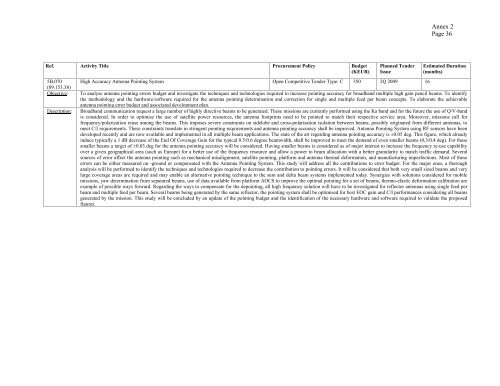ARTES-5.1 â ESA Telecom Technology Workplan ... - Emits - ESA
ARTES-5.1 â ESA Telecom Technology Workplan ... - Emits - ESA
ARTES-5.1 â ESA Telecom Technology Workplan ... - Emits - ESA
- No tags were found...
Create successful ePaper yourself
Turn your PDF publications into a flip-book with our unique Google optimized e-Paper software.
Annex 2Page 36Ref. Activity Title Procurement Policy Budget(KEUR)5B.070(09.153.38)Objective:Description:Planned TenderIssueHigh Accuracy Antenna Pointing System Open Competitive Tender Type: C 350 2Q 2009 16Estimated Duration(months)To analyse antenna pointing errors budget and investigate the techniques and technologies required to increase pointing accuracy for broadband multiple high gain pencil beams. To identifythe methodology and the hardware/software required for the antenna pointing determination and correction for single and multiple feed per beam concepts. To elaborate the achievableantenna pointing error budget and associated development plan.Broadband communication request a large number of highly directive beams to be generated. These missions are currently performed using the Ka band and for the future the use of Q/V-bandis considered. In order to optimise the use of satellite power resources, the antenna footprints need to be pointed to match their respective service area. Moreover, missions call forfrequency/polarization reuse among the beams. This imposes severe constraints on sidelobe and cross-polarisation isolation between beams, possibly originated from different antennas, tomeet C/I requirements. These constraints translate in stringent pointing requirements and antenna pointing accuracy shall be improved. Antenna Pointing System using RF sensors have beendeveloped recently and are now available and implemented in all multiple beam applications. The state of the art regarding antenna pointing accuracy is ±0.05 deg. This figure, which alreadyinduce typically a 1 dB decrease of the End Of Coverage Gain for the typical 0.5/0.6 degree beamwidth, shall be improved to meet the demand of even smaller beams (0,3/0.4 deg). For thesesmaller beams a target of ±0.03 deg for the antenna pointing accuracy will be considered. Having smaller beams is considered as of major interest to increase the frequency re-use capabilityover a given geographical area (such as Europe) for a better use of the frequency resource and allow a power to beam allocation with a better granularity to match traffic demand. Severalsources of error affect the antenna pointing such as mechanical misalignment, satellite pointing, platform and antenna thermal deformation, and manufacturing imperfections. Most of theseerrors can be either measured on -ground or compensated with the Antenna Pointing System. This study will address all the contributions to error budget. For the major ones, a thoroughanalysis will be performed to identify the techniques and technologies required to decrease the contribution to pointing errors. It will be considered that both very small sized beams and verylarge coverage areas are required and may enable an alternative pointing technique to the sum and delta beam systems implemented today. Synergies with solutions considered for mobilemissions, yaw determination from separated beams, use of data available from platform AOCS to improve the optimal pointing for a set of beams, thermo-elastic deformation calibration areexample of possible ways forward. Regarding the ways to compensate for the depointing, all high frequency solution will have to be investigated for reflector antennas using single feed perbeam and multiple feed per beam. Several beams being generated by the same reflector, the pointing system shall be optimised for best EOC gain and C/I performances considering all beamsgenerated by the mission. This study will be concluded by an update of the pointing budget and the identification of the necessary hardware and software required to validate the proposedfigures.
















